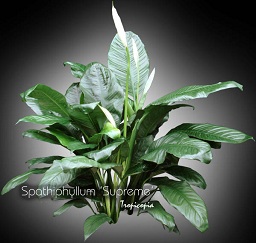Table of contents
Peace lily

Latin Name: Spathiphyllum ‘Supreme’
Category: Spathiphyllum
Family: Liliaceae
Origin: Cultivar
Climate: Tropical
Growing Zones: 11-12
Care Instructions
The Peace lily (Spathiphyllum ‘Supreme’) is a tropical plant that originates from Cultivar. This spathiphyllum plant belongs to the Liliaceae family and is well-suited for growing in USDA zones 11-12.
Complete Care Guide for Peace Lily (Spathiphyllum ‘Supreme’)
Watering Requirements
The Peace Lily thrives in consistently moist soil, but it is crucial to avoid overwatering, which can lead to root rot. Water the plant when the top inch of soil feels dry to the touch. Typically, this means watering once a week, but frequency may vary based on environmental conditions such as humidity and temperature. During the growing season (spring and summer), the plant may require more frequent watering, while in the dormant season (fall and winter), you can reduce watering. Always ensure that excess water can drain freely from the pot to prevent waterlogging.
Light Conditions
Peace Lilies prefer bright, indirect light but can also tolerate low-light conditions. Direct sunlight can scorch their leaves, leading to brown tips and wilting. Ideally, place your Peace Lily near a window with filtered light or in a well-lit room where it can receive indirect sunlight for several hours a day. If the plant is not receiving enough light, it may produce fewer flowers and exhibit slower growth. Conversely, if the leaves start to yellow, it may be a sign of too much direct sunlight.
Soil Preferences
The ideal soil for a Peace Lily is a well-draining potting mix that retains moisture without becoming soggy. A mix of peat moss, perlite, and pine bark works well, providing both aeration and moisture retention. It is advisable to repot your Peace Lily every couple of years to refresh the soil and provide more space for growth. During the growing season, you can feed your Peace Lily with a balanced, water-soluble fertilizer every 6-8 weeks to promote healthy growth and flowering. Be cautious not to over-fertilize, as this can lead to salt buildup and damage the roots.
Pests and Diseases
Common pests that may affect Peace Lilies include spider mites, aphids, and mealybugs. Regularly inspect the leaves for signs of infestation, such as webbing or sticky residue. If you notice pests, treat the plant with insecticidal soap or neem oil, ensuring to cover both the tops and undersides of the leaves. Additionally, Peace Lilies can be susceptible to diseases like root rot and leaf spot. To prevent root rot, ensure proper drainage and avoid overwatering. Leaf spot can be managed by removing affected leaves and improving air circulation around the plant.
Special Care Tips
To keep your Peace Lily healthy and thriving, consider the following special care tips: First, wipe the leaves with a damp cloth regularly to remove dust, which can hinder photosynthesis. Second, Peace Lilies are sensitive to fluoride and chlorine found in tap water; using distilled or rainwater can help prevent leaf tip burn. Third, if your Peace Lily is not flowering, it may need more light or a boost in nutrients, so adjust its placement or fertilization schedule accordingly. Lastly, be mindful of temperature; Peace Lilies prefer temperatures between 65°F and 85°F (18°C to 29°C) and should be kept away from cold drafts or sudden temperature changes.








